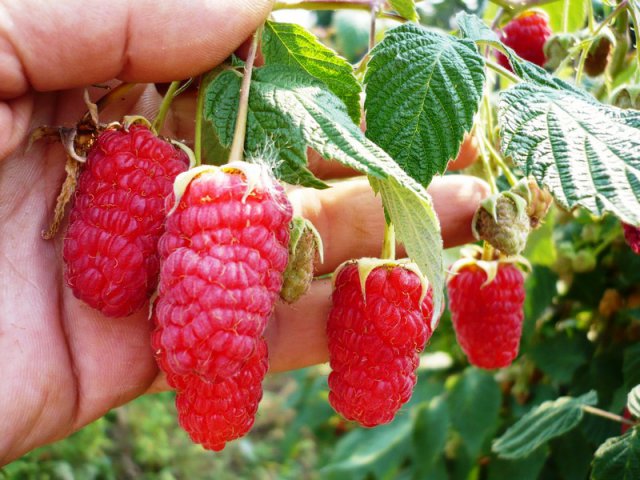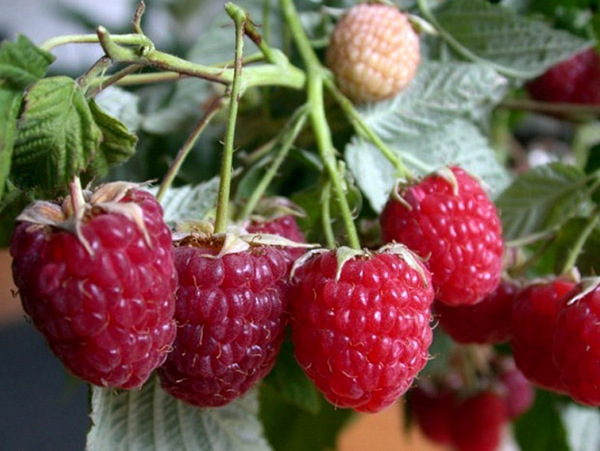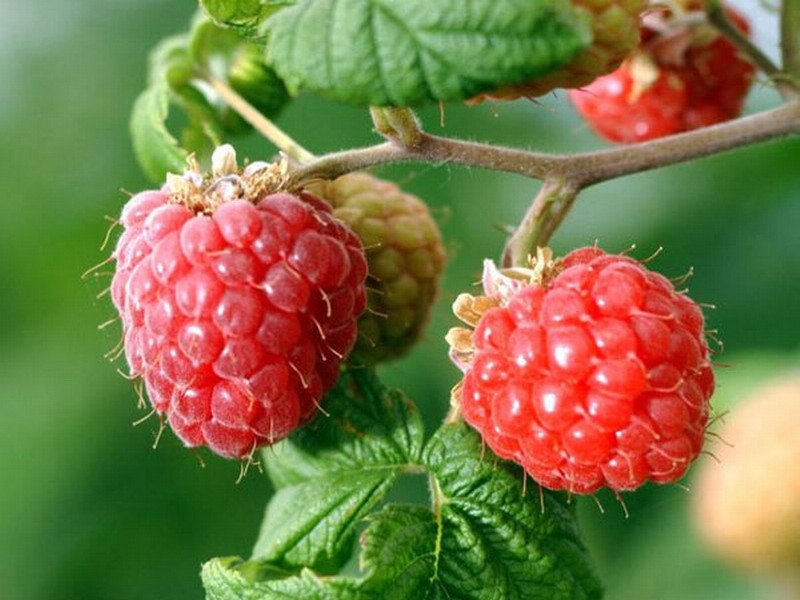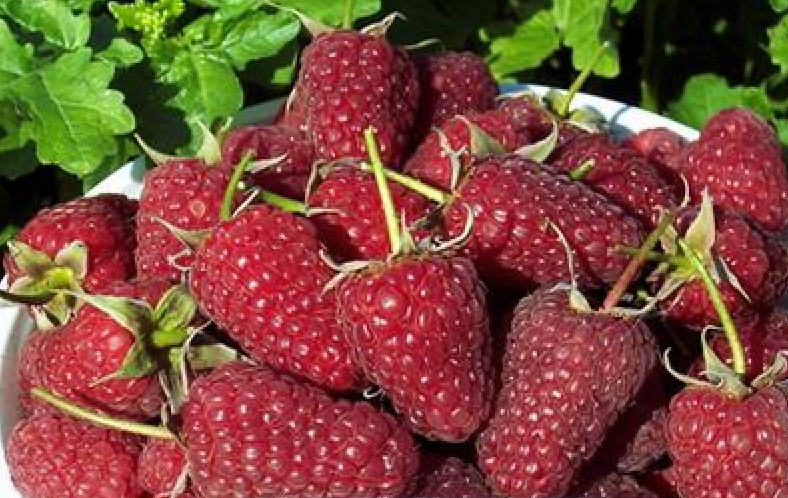The best varieties of remontant raspberries with descriptions and photos
Content
Characteristics of the species
Repaired raspberries can bear fruit on both annual and biennial sprouts. That is, the second harvest can be obtained in the same year, on new shoots that ripen by autumn. For the first time this ability of raspberries was noticed by gardeners 200 years ago. Since then, breeders have been tirelessly working to develop more and more new varieties that surpass the previous ones in yield and taste.
 In general, remontant raspberry is a perennial shrub with a perennial rhizome, adventitious roots, annual and biennial shoots. Many varieties bred by breeders practically do not give growth, which somewhat complicates the breeding process. In agricultural technology, remontant raspberries are superior to ordinary raspberries, since they do not require special growing conditions and are easier to tolerate weather conditions.
In general, remontant raspberry is a perennial shrub with a perennial rhizome, adventitious roots, annual and biennial shoots. Many varieties bred by breeders practically do not give growth, which somewhat complicates the breeding process. In agricultural technology, remontant raspberries are superior to ordinary raspberries, since they do not require special growing conditions and are easier to tolerate weather conditions.
 Most of the first varieties bred were suitable for cultivation only in the southern regions of Russia and Ukraine. In the conditions of the Moscow region and Siberia, they did not survive and did not give the expected harvest, since the berries did not have time to ripen before the onset of the first frost. To date, this problem has been solved and below we will present varieties that bear fruit in colder climates.
Most of the first varieties bred were suitable for cultivation only in the southern regions of Russia and Ukraine. In the conditions of the Moscow region and Siberia, they did not survive and did not give the expected harvest, since the berries did not have time to ripen before the onset of the first frost. To date, this problem has been solved and below we will present varieties that bear fruit in colder climates.
The best varieties
It is impossible to describe all varieties of remontant raspberries. There are more than 60 of them. Each has its own characteristics of reproduction, color of berries, size, disease resistance, yield, soil requirements. Experienced gardeners know that almost all varieties of remontant raspberries show excellent results in areas with mild climates and late frosts. Therefore, most of all summer residents are interested in those species that are suitable for the Moscow region and the North of Ukraine.
The Brilliant raspberry variety is distinguished by good yield and versatility of the use of berries. Raspberry grows in a conical shape with a rich ruby hue. It tastes sweet and sour. Each berry grows to an average of 5-7 grams. From 1 bush, you can collect up to 3 kilograms of the crop. The berries ripen by the end of August and continue to pour until October. At the same time, ripe fruits are kept on the shoots for a long time, so harvesting does not need to be carried out often, removing raspberries in small parts.
The Hat Monomakh variety is distinguished by a special structure of the bush. The plant looks like a short tree (1.5 meters) with 3-4 drooping shoots, on which multiple branches are formed. The thorns are quite massive, but there are few of them and they are concentrated closer to the surface of the earth. This variety is loved by all gardeners of the Moscow region, the Central District and Ukraine for its large and elastic berries. With proper care and favorable weather conditions, raspberries can grow up to 10 grams each. Accordingly, the variety has high productivity. One bush gives up to 5-6 kilograms of berries. But such a result is possible only in the southern zones. In the conditions of the Moscow region and the North of Ukraine, about 2-3 kilograms of raspberries have time to ripen before the onset of cold weather.
 One of the most popular varieties of remontant raspberries is called Autumn Beauty. It is unusually fruitful.An average of 5-7 kilograms of berries are harvested from one bush. Raspberries grow to a medium size of 3-4 grams. The taste is excellent. When harvesting, raspberries are easily removed from the stalk. Bushes grow compactly up to 1 meter in height. In the Moscow region, the height of autumn fruiting is observed in the period from 10 to 15 September.
One of the most popular varieties of remontant raspberries is called Autumn Beauty. It is unusually fruitful.An average of 5-7 kilograms of berries are harvested from one bush. Raspberries grow to a medium size of 3-4 grams. The taste is excellent. When harvesting, raspberries are easily removed from the stalk. Bushes grow compactly up to 1 meter in height. In the Moscow region, the height of autumn fruiting is observed in the period from 10 to 15 September.
Also, for the Central region of Russia and Ukraine, varieties such as the August Miracle, Golden Domes, Hercules are perfect. Until October, these new subspecies manage to give summer residents up to 80-90% of the potential harvest, while one of the first varieties of remontant raspberries, Babie Leto, in the Moscow Region, yielded only 30% of fruit.
Planting, Care and Harvesting Video
How to grow
First of all, gardeners should pay attention to the location of the site and the characteristics of the soil. Raspberries love well-lit areas. If the place is shaded, then the crop will not have time to fully ripen before the onset of frost. Although if the direct sun constantly shines on ripening berries, they may burn out. Therefore, it is necessary to monitor the activity of the sun's rays and, if necessary, shade the plantings with a special net.
Raspberries love fertile soil. Before planting, it is important to analyze the soil and then add 2-3 buckets of humus, 200-400 grams of superphosphate, 100-200 grams of potassium dressing and 200-400 grams of complex mineral fertilizers per 1 square meter. Also pay attention to the presence of weeds. If the area is infested with perennial weeds, use a Roundup herbicide. Never plant raspberries on areas where nightshades (bell peppers, eggplants, tomatoes, potatoes) grew before.
 When preparing for planting young shoots, think about how many seedlings you need. On average, experts recommend planting no more than 10 plants per square meter of land. When thickening, raspberries begin to bear fruit worse. There are several options for planting remontant raspberries tape, bush and ordinary.
When preparing for planting young shoots, think about how many seedlings you need. On average, experts recommend planting no more than 10 plants per square meter of land. When thickening, raspberries begin to bear fruit worse. There are several options for planting remontant raspberries tape, bush and ordinary.
With the belt method, the seedlings are placed in 2 lines with a minimum gap of 60 centimeters. The distance between the belts must be at least one and a half meters. The bush planting method involves placing seedlings in separate pits measuring 40X40X40 centimeters. With an ordinary planting method, seedlings are planted in a row at a distance of 0.5-1 meter. There should be at least one and a half meters of free space between the radas.
Raspberry care
Caring for remontant raspberries is quite standard. The main thing is to monitor the level of moisture in the soil, since plants have surface roots and in dry weather they very quickly begin to lose moisture. In this case, watering should be moderate. Also raspberries love loosening. It should be carried out carefully at a distance of about 1 meter from the bush and to a depth of no more than 5 centimeters. This is due to the same superficial location of the roots. Raspberries respond well to feeding during the growing season. If you use an infusion of chicken manure, then the solution must be made in a ratio of 1:20, but if you take a mullein, then in a ratio of 1:10. In the first half of summer, you can apply 4 liters of such organic fertilizers per 1 square meter.
 After fruiting is complete, it is important to prune the fruiting shoots. Such work is carried out in late autumn, when the ground has cooled down enough and stable frosts have been established. Shoots are removed at the very root so that no ground stumps remain, since raspberry moths can settle there. In the second year, in the spring, young root suckers are selected. Only the healthiest and largest shoots are left. To rejuvenate the planting, it is recommended to dig out old rhizomes every 5 years.
After fruiting is complete, it is important to prune the fruiting shoots. Such work is carried out in late autumn, when the ground has cooled down enough and stable frosts have been established. Shoots are removed at the very root so that no ground stumps remain, since raspberry moths can settle there. In the second year, in the spring, young root suckers are selected. Only the healthiest and largest shoots are left. To rejuvenate the planting, it is recommended to dig out old rhizomes every 5 years.
Video "How to choose a variety"
This video tells about the different varieties of remontant raspberries, as well as how to choose the right planting material.
